Abstract
This paper compares leg muscle electromyogram (EMG) responses to sudden toe-up tilts of a moveable platform in patients with Huntington's disease (HD), clinically normal offspring at risk of developing HD (HD risks) and healthy controls. The EMG pattern in standing subjects and patients consisted of short- and middle-latency responses (SL and ML) in the stretched triceps surae muscles and long-latency responses (LL) in the shortened tibialis anterior muscles. The SL response could be further divided into two distinct subcomponents termed SL1 and SL2. An ML response was identified in only 50% of normal subjects and patients. HD patients differed from normal subjects by showing delayed onset latencies and prolonged durations for the LL response, and smaller amplitudes for the ML response. The subjects at risk also showed diminished ML amplitudes and prolonged LL durations, but normal LL onset latencies. In the sitting condition, the EMG responses of the HD patients and of the HD risks did not differ from those of controls: in all groups SL1 was reduced and delayed, SL2 slightly enhanced, while ML and LL were absent. Because both afferent and efferent conduction times are normal in HD, the delayed LL onset reflects abnormal supraspinal organisation of postural control in HD, and indicates that basal ganglia may have a modulatory effect on the LL responses. The normal EMG responses in the sitting patients suggest appropriate regulation of these responses according to postural set in HD.
Full text
PDF

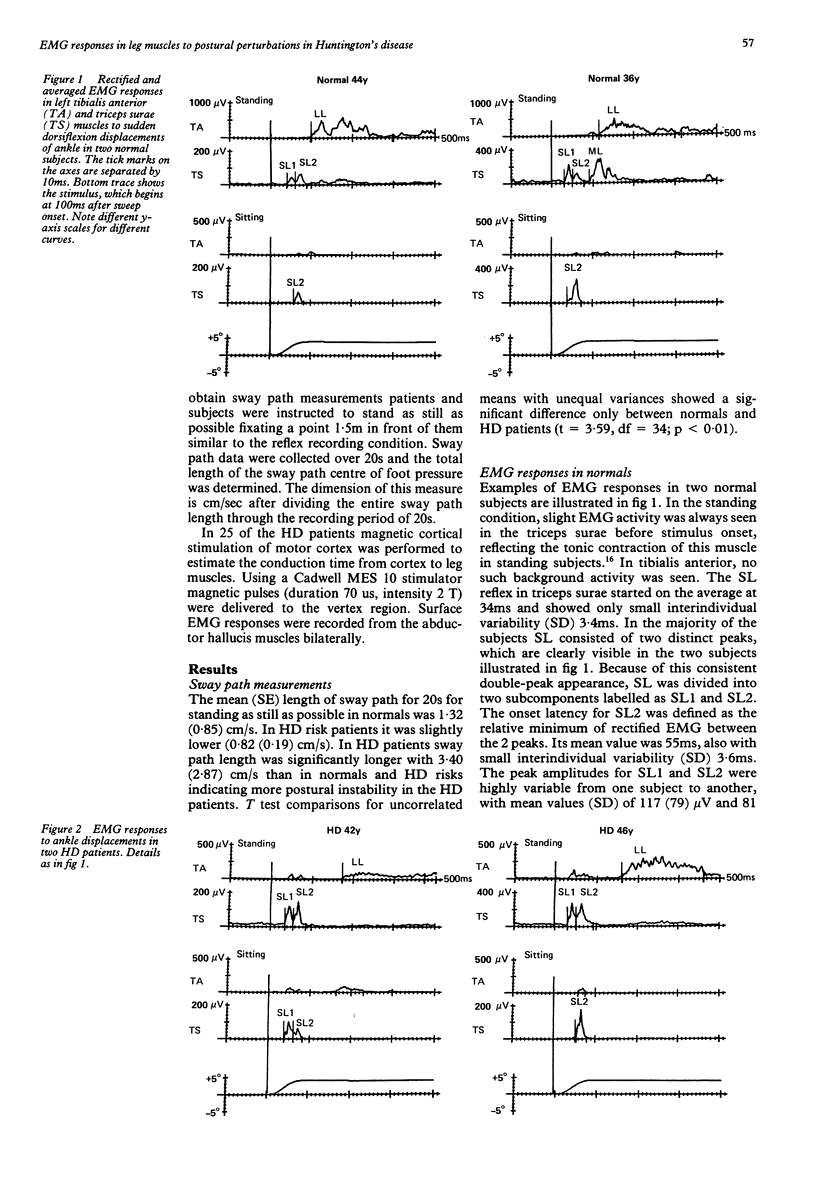
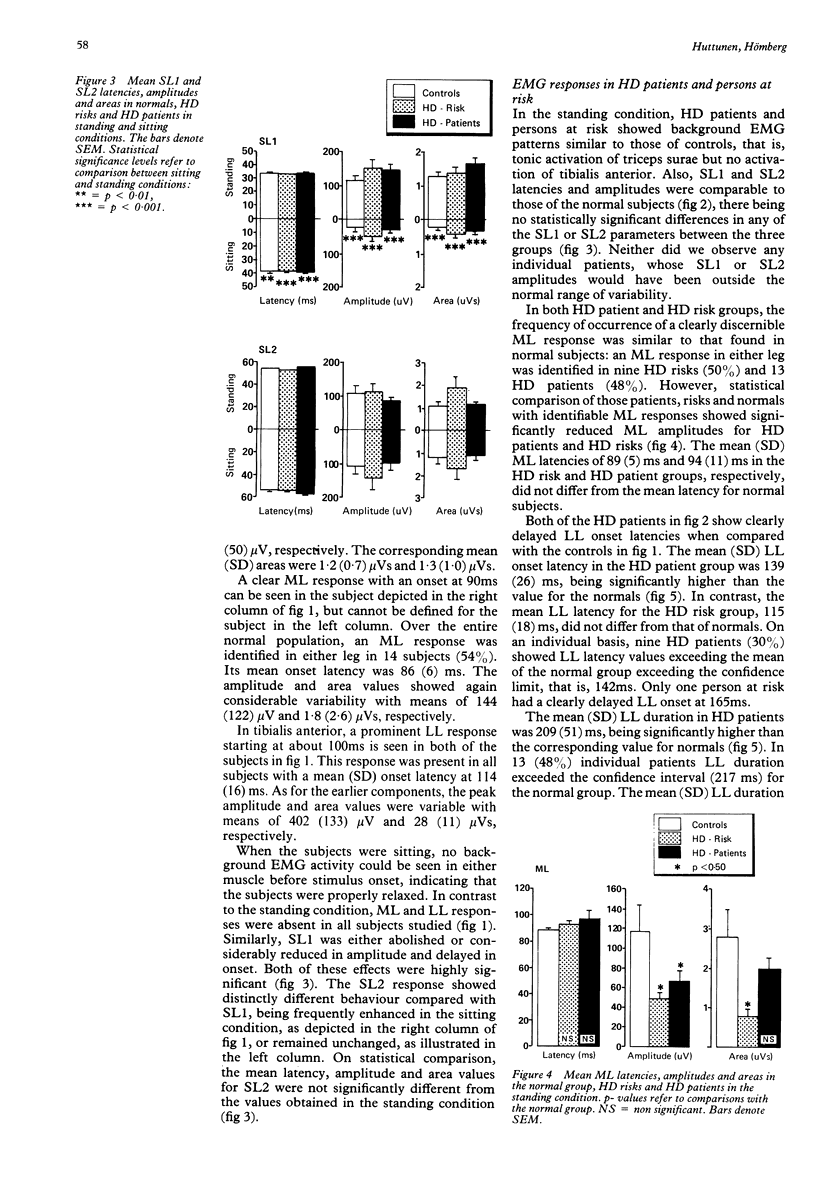

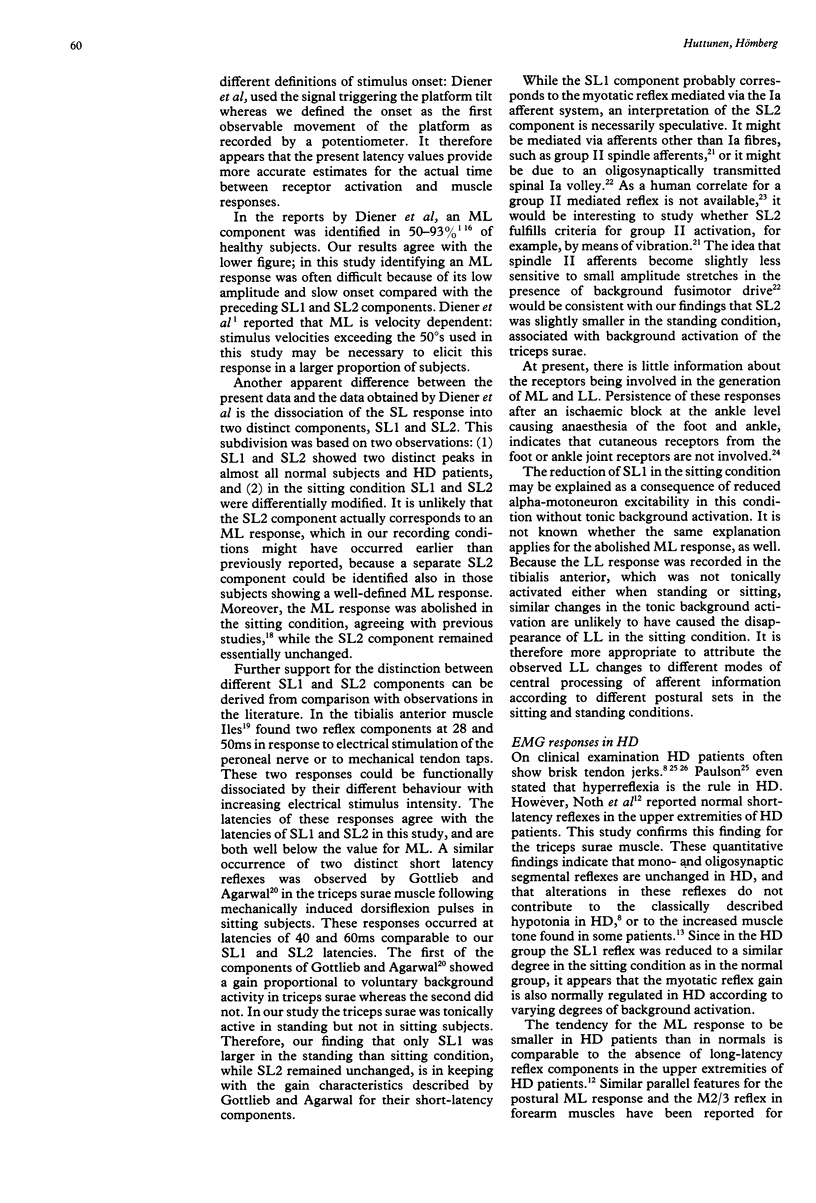
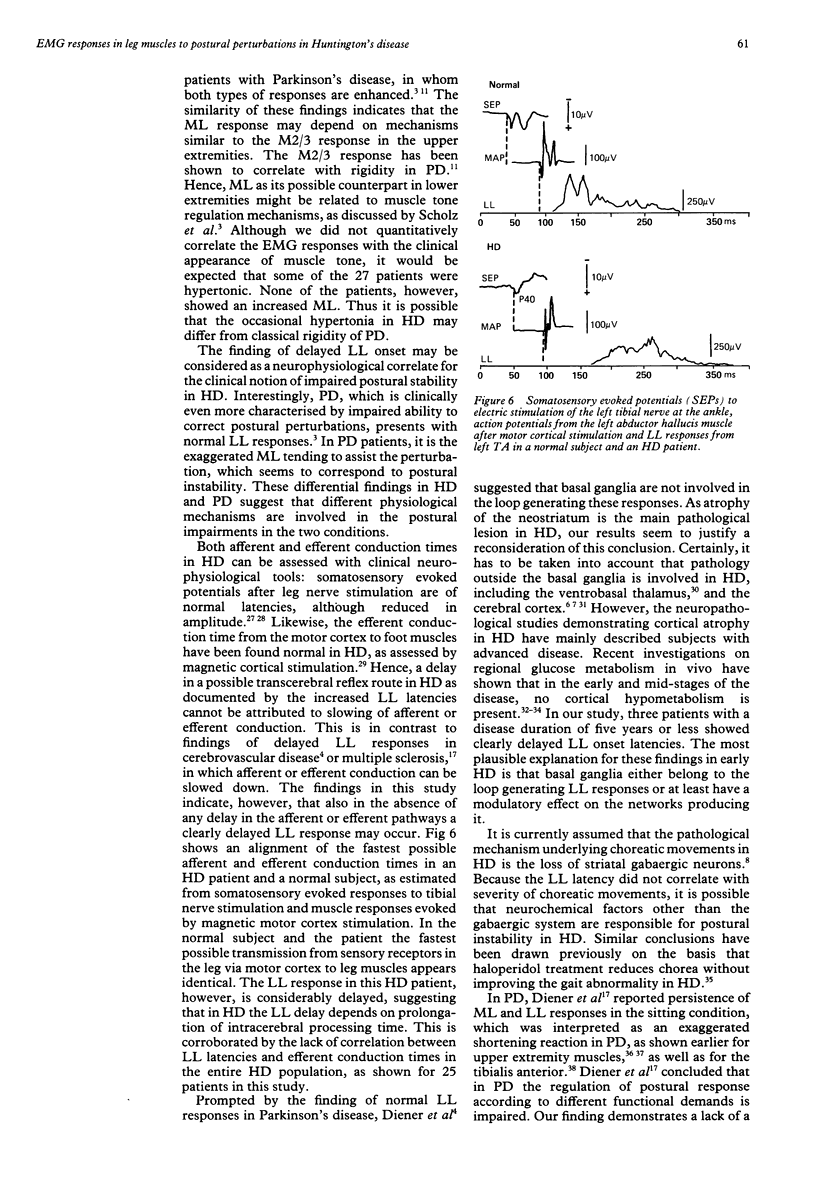
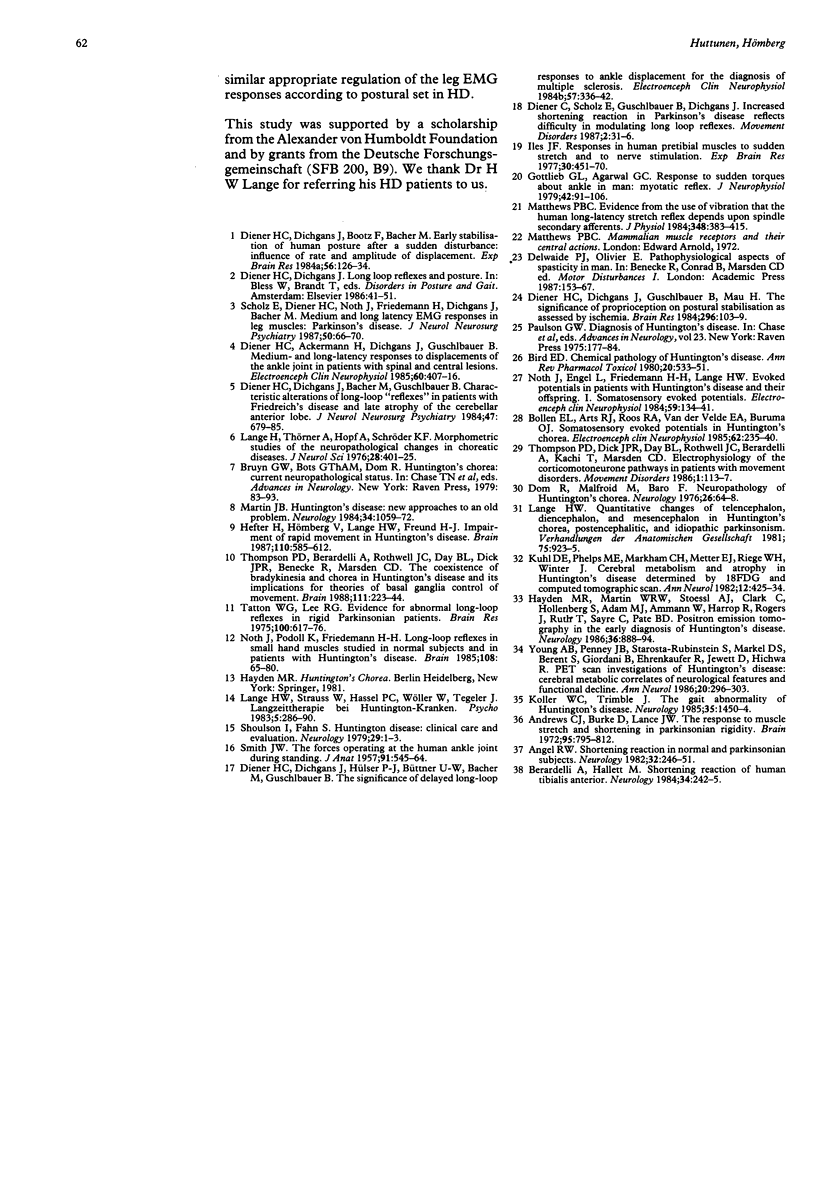
Selected References
These references are in PubMed. This may not be the complete list of references from this article.
- Andrews C. J., Burke D., Lance J. W. The response to muscle stretch and shortening in Parkinsonian rigidity. Brain. 1972;95(4):795–812. doi: 10.1093/brain/95.4.795. [DOI] [PubMed] [Google Scholar]
- Angel R. W. Shortening reaction in normal and parkinsonian subjects. Neurology. 1982 Mar;32(3):246–251. doi: 10.1212/wnl.32.3.246. [DOI] [PubMed] [Google Scholar]
- Berardelli A., Hallett M. Shortening reaction of human tibialis anterior. Neurology. 1984 Feb;34(2):242–245. doi: 10.1212/wnl.34.2.242. [DOI] [PubMed] [Google Scholar]
- Bird E. D. Chemical pathology of Huntington's disease. Annu Rev Pharmacol Toxicol. 1980;20:533–551. doi: 10.1146/annurev.pa.20.040180.002533. [DOI] [PubMed] [Google Scholar]
- Bollen E. L., Arts R. J., Roos R. A., Van der Velde E. A., Buruma O. J. Somatosensory evoked potentials in Huntington's chorea. Electroencephalogr Clin Neurophysiol. 1985 Jul;62(4):235–240. doi: 10.1016/0168-5597(85)90001-2. [DOI] [PubMed] [Google Scholar]
- Diener C., Scholz E., Guschlbauer B., Dichgans J. Increased shortening reaction in Parkinson's disease reflects a difficulty in modulating long loop reflexes. Mov Disord. 1987;2(1):31–36. doi: 10.1002/mds.870020104. [DOI] [PubMed] [Google Scholar]
- Diener H. C., Ackermann H., Dichgans J., Guschlbauer B. Medium- and long-latency responses to displacements of the ankle joint in patients with spinal and central lesions. Electroencephalogr Clin Neurophysiol. 1985 May;60(5):407–416. doi: 10.1016/0013-4694(85)91014-4. [DOI] [PubMed] [Google Scholar]
- Diener H. C., Dichgans J., Bacher M., Guschlbauer B. Characteristic alterations of long-loop "reflexes" in patients with Friedreich's disease and late atrophy of the cerebellar anterior lobe. J Neurol Neurosurg Psychiatry. 1984 Jul;47(7):679–685. doi: 10.1136/jnnp.47.7.679. [DOI] [PMC free article] [PubMed] [Google Scholar]
- Diener H. C., Dichgans J., Bootz F., Bacher M. Early stabilization of human posture after a sudden disturbance: influence of rate and amplitude of displacement. Exp Brain Res. 1984;56(1):126–134. doi: 10.1007/BF00237448. [DOI] [PubMed] [Google Scholar]
- Diener H. C., Dichgans J., Guschlbauer B., Mau H. The significance of proprioception on postural stabilization as assessed by ischemia. Brain Res. 1984 Mar 26;296(1):103–109. doi: 10.1016/0006-8993(84)90515-8. [DOI] [PubMed] [Google Scholar]
- Dom R., Malfroid M., Baro F. Neuropathology of Huntington's chorea. Studies of the ventrobasal complex of the thalamus. Neurology. 1976 Jan;26(1):64–68. doi: 10.1212/wnl.26.1.64. [DOI] [PubMed] [Google Scholar]
- Gottlieb G. L., Agarwal G. C. Response to sudden torques about ankle in man: myotatic reflex. J Neurophysiol. 1979 Jan;42(1 Pt 1):91–106. doi: 10.1152/jn.1979.42.1.91. [DOI] [PubMed] [Google Scholar]
- Hayden M. R., Martin W. R., Stoessl A. J., Clark C., Hollenberg S., Adam M. J., Ammann W., Harrop R., Rogers J., Ruth T. Positron emission tomography in the early diagnosis of Huntington's disease. Neurology. 1986 Jul;36(7):888–894. doi: 10.1212/wnl.36.7.888. [DOI] [PubMed] [Google Scholar]
- Hefter H., Hömberg V., Lange H. W., Freund H. J. Impairment of rapid movement in Huntington's disease. Brain. 1987 Jun;110(Pt 3):585–612. doi: 10.1093/brain/110.3.585. [DOI] [PubMed] [Google Scholar]
- Iles J. F. Responses in human pretibial muscles to sudden stretch and to nerve stimulation. Exp Brain Res. 1977 Dec 19;30(4):451–470. doi: 10.1007/BF00237637. [DOI] [PubMed] [Google Scholar]
- Koller W. C., Trimble J. The gait abnormality of Huntington's disease. Neurology. 1985 Oct;35(10):1450–1454. doi: 10.1212/wnl.35.10.1450. [DOI] [PubMed] [Google Scholar]
- Kuhl D. E., Phelps M. E., Markham C. H., Metter E. J., Riege W. H., Winter J. Cerebral metabolism and atrophy in Huntington's disease determined by 18FDG and computed tomographic scan. Ann Neurol. 1982 Nov;12(5):425–434. doi: 10.1002/ana.410120504. [DOI] [PubMed] [Google Scholar]
- Lange H., Thörner G., Hopf A., Schröder K. F. Morphometric studies of the neuropathological changes in choreatic diseases. J Neurol Sci. 1976 Aug;28(4):401–425. doi: 10.1016/0022-510x(76)90114-3. [DOI] [PubMed] [Google Scholar]
- Martin J. B. Huntington's disease: new approaches to an old problem. The Robert Wartenberg lecture. Neurology. 1984 Aug;34(8):1059–1072. doi: 10.1212/wnl.34.8.1059. [DOI] [PubMed] [Google Scholar]
- Matthews P. B. Evidence from the use of vibration that the human long-latency stretch reflex depends upon spindle secondary afferents. J Physiol. 1984 Mar;348:383–415. doi: 10.1113/jphysiol.1984.sp015116. [DOI] [PMC free article] [PubMed] [Google Scholar]
- Noth J., Engel L., Friedemann H. H., Lange H. W. Evoked potentials in patients with Huntington's disease and their offspring. I. Somatosensory evoked potentials. Electroencephalogr Clin Neurophysiol. 1984 Apr;59(2):134–141. doi: 10.1016/0168-5597(84)90029-7. [DOI] [PubMed] [Google Scholar]
- Noth J., Podoll K., Friedemann H. H. Long-loop reflexes in small hand muscles studied in normal subjects and in patients with Huntington's disease. Brain. 1985 Mar;108(Pt 1):65–80. doi: 10.1093/brain/108.1.65. [DOI] [PubMed] [Google Scholar]
- SMITH J. W. The forces operating at the human ankle joint during standing. J Anat. 1957 Oct;91(4):545–564. [PMC free article] [PubMed] [Google Scholar]
- Scholz E., Diener H. C., Noth J., Friedemann H., Dichgans J., Bacher M. Medium and long latency EMG responses in leg muscles: Parkinson's disease. J Neurol Neurosurg Psychiatry. 1987 Jan;50(1):66–70. doi: 10.1136/jnnp.50.1.66. [DOI] [PMC free article] [PubMed] [Google Scholar]
- Shoulson I., Fahn S. Huntington disease: clinical care and evaluation. Neurology. 1979 Jan;29(1):1–3. doi: 10.1212/wnl.29.1.1. [DOI] [PubMed] [Google Scholar]
- Thompson P. D., Berardelli A., Rothwell J. C., Day B. L., Dick J. P., Benecke R., Marsden C. D. The coexistence of bradykinesia and chorea in Huntington's disease and its implications for theories of basal ganglia control of movement. Brain. 1988 Apr;111(Pt 2):223–244. doi: 10.1093/brain/111.2.223. [DOI] [PubMed] [Google Scholar]
- Young A. B., Penney J. B., Starosta-Rubinstein S., Markel D. S., Berent S., Giordani B., Ehrenkaufer R., Jewett D., Hichwa R. PET scan investigations of Huntington's disease: cerebral metabolic correlates of neurological features and functional decline. Ann Neurol. 1986 Sep;20(3):296–303. doi: 10.1002/ana.410200305. [DOI] [PubMed] [Google Scholar]


